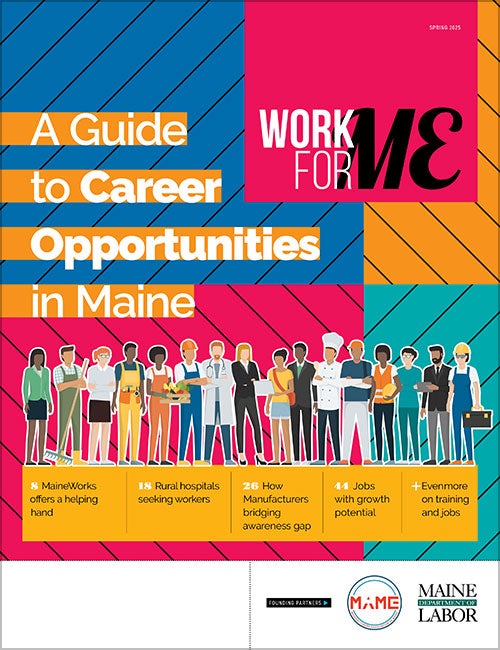
Processing Your Payment
Please do not leave this page until complete. This can take a few moments.
- News
-
Editions
View Digital Editions
Biweekly Issues
- December 1, 2025
- Nov. 17, 2025
- November 03, 2025
- October 20, 2025
- October 6, 2025
- September 22, 2025
- + More
Special Editions
- Lists
- Viewpoints
-
Our Events
Event Info
Award Honorees
- Calendar
- Biz Marketplace
Bill that would create life sciences innovation center in Maine clears early hurdle

A proposal to create a Life Science Innovation Center in Maine took a step forward Thursday.

During a life science-focused webinar and panel discussion hosted on May 1, Agnieszka Carpenter, executive director of the Bioscience Association of Maine (BioME), announced in real time that Bill LD 1643 had unanimously passed the Housing and Economic Development Committee and would proceed to the state Senate and House of Representatives.
The bill focuses on expanding Maine’s $2.3 billion life science sector, which is already on course to outpace the state’s other industries, by creating a Life Science Innovation Center.
The new organization would focus on marketing Maine as a destination for life science innovation and research by advocating for policies that make the state more competitive, growing the talent pool and formulating strategies to enhance the state’s attractiveness to life science companies.
Sponsored by state Sen. Teresa Pierce, D-Cumberland, LD 1643 requests a one-time $2 million allocation in fiscal years 2025-26 and 2026-27 to cover the center’s startup costs. The goal is to establish a public-private entity that can eventually sustain itself through grants and philanthropic support, explained Carpenter.
Thursday's BioME webinar focused on the economic advantages of expanding the life sciences sector in the state and featured expert panelists, Dr. Aileen Huang-Saad from the Roux Institute, Owen McCarthy from MedRhythms, Sarah Delmar from FocusMaine and Jeri Bowers from MDI Biological Laboratory.
Making Maine a global competitor
Maine has 587 life science companies, but the goal is to further expand that sector and make the state a worldwide beacon of research, innovation and investment.
“I think it's really important to remember that this is a game for global competitiveness. It's not just about Maine, and with the people who are winning in the space, there's a tried and true playbook for how they're winning, and we can learn from those best practices and leverage them here in Maine,” said Sarah Delmar, chair of the bioscience advisory team at FocusMaine, “It's very important to signal to the world that we are open for business and that we have a brand identity around the space here in Maine, and that we get really good at telling our story.”
Delmar pointed to the success of similar organizations such as the Massachusetts Life Sciences Center, which had a 19 times return on investment for every dollar invested, and a North Carolina center, which experienced a 70% return.
One of Maine’s key challenges is that, despite being a popular tourist destination, it’s not commonly seen as a hub for life science companies or investors. A main responsibility of the proposed center would be to promote Maine’s life science sector and position the state as an attractive destination for the industry.
“I'll speak specifically about Mount Desert Island. So, we have probably the largest concentration of billionaires for three months out of the year…and a lot of those folks are very actively involved in venture investment. But in talking with a number of them, they just don't think about Maine as a place where that investment is possible,” said Jeri Bowers, vice president of external affairs and chief of staff at MDI Biological Laboratory.
“I think we have a really unique opportunity to begin to market, and again, it gets back to that mind shift," Bowers continued. "When I talked to them, they were like, ‘Well, we'd love to invest in more Maine companies, but we just don't know. We don't know where those opportunities lie.’ And so that's on us, right? We need to do more to make those opportunities really visible for people.”
Navigating workforce obstacles
As Maine actively works to draw life sciences businesses into the state, it needs to attract and retain a workforce able to support the accelerated growth. In 2024, the sector employed 10,000 in the state with hopes to grow. However, the state, along with the nation, is grappling with workforce disruptions.
While not a physical facility, the Life Science Innovation Center’s ability to connect early-stage life science companies with resources could help overcome Maine’s geographic and population challenges, where qualified talent is widely dispersed and isolated, said Dr. Aileen Huang-Saad, director of life sciences, health and engineering programs at the Portland-based Roux Institute at Northeastern University.
“A center like this will be able to help people navigate things and bring us all into a sort of harmony, as opposed to being disconnected,” she said.
Research by the congressional delegation and the state recognized that students start thinking about their career paths in middle school. To improve the future talent pipeline, Educate Maine, BioME, the Roux Institute and Learning Undefeated collaborated to create the Maine Mobile BioLab. The portable lab space introduces K-12 students to the world of STEM, an impressive feat given the state’s geography.
“If we want students to think about engaging in the life sciences, you want them to be exposed to those opportunities,” Huang-Saad said.
Looking to the future
The life sciences sector in Maine was already an emerging force, touting a 31% employment boost between 2018 and 2023, outpacing surrounding New England states, according to BioME. This forward momentum has been further ignited by the passage of LD 1643 as it makes its way to the State Senate and House of Representatives.
The proposed center is imperative to defining a strategy for future investment, life science education, talent diversity, and industry collaboration, said Owen McCarthy, president and co-founder of MedRhythms.
“I just see this whole stack of things that could come out from having a strategy with a life science center that I don't think we could have done 10 years ago, because the critical mass wasn't here. We now have 10,000 jobs and a lot of institutions, and it's an exciting time to have a plan versus an emerging strategy in the sector,” McCarthy said.
Mainebiz web partners
Related Content

The Giving Guide
The Giving Guide helps nonprofits have the opportunity to showcase and differentiate their organizations so that businesses better understand how they can contribute to a nonprofit’s mission and work.
Learn More
Work for ME
Work for ME is a workforce development tool to help Maine’s employers target Maine’s emerging workforce. Work for ME highlights each industry, its impact on Maine’s economy, the jobs available to entry-level workers, the training and education needed to get a career started.
Learn More
Groundbreaking Maine
Whether you’re a developer, financer, architect, or industry enthusiast, Groundbreaking Maine is crafted to be your go-to source for valuable insights in Maine’s real estate and construction community.
Learn more-
The Giving Guide
The Giving Guide helps nonprofits have the opportunity to showcase and differentiate their organizations so that businesses better understand how they can contribute to a nonprofit’s mission and work.
-
Work for ME
Work for ME is a workforce development tool to help Maine’s employers target Maine’s emerging workforce. Work for ME highlights each industry, its impact on Maine’s economy, the jobs available to entry-level workers, the training and education needed to get a career started.
-
Groundbreaking Maine
Whether you’re a developer, financer, architect, or industry enthusiast, Groundbreaking Maine is crafted to be your go-to source for valuable insights in Maine’s real estate and construction community.
ABOUT
NEW ENGLAND BUSINESS MEDIA SITES
No articles left
Get access now
In order to use this feature, we need some information from you. You can also login or register for a free account.
By clicking submit you are agreeing to our cookie usage and Privacy Policy
Already have an account? Login
Already have an account? Login
Want to create an account? Register
Get access now
In order to use this feature, we need some information from you. You can also login or register for a free account.
By clicking submit you are agreeing to our cookie usage and Privacy Policy
Already have an account? Login
Already have an account? Login
Want to create an account? Register











0 Comments